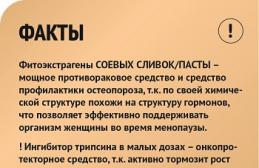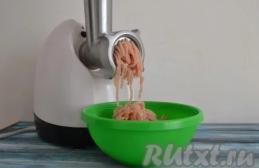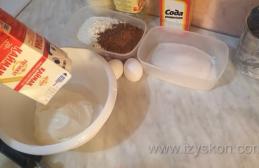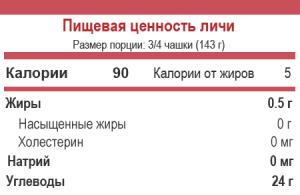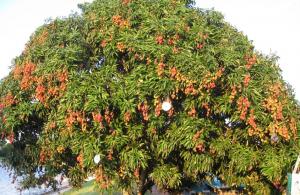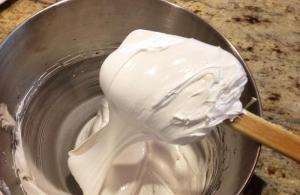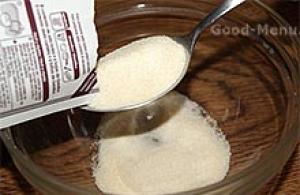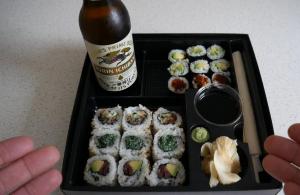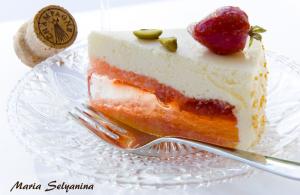For this dish, it is important to choose the right meat, because in essence we will be cooking classic roast beef. It's for roast beef beef edge.
Thick end beef is a fine-fibered, soft meat with 4 or 5 ribs. In this case, the bones are usually cut out and the meat is rolled up.
Thin beef rib is a tender cut of meat containing 2 or 3 ribs, and it is usually baked with the bones. This is how steaks and grilled meats are prepared.
Our option is the first, since we will cook roast beef.
Ingredients
Beef edge thick, 1½ kg pulp
Vegetable oil, 50 ml
1 onion
1 stalk of celery
1 carrot
Ground black pepper
Herbs - bouquet garni
A bouquet garni is a set of French herbs: 1 sprig of thyme, 3 sprigs of parsley, bay leaf, garlic, sage, leek and other herbs may be present. This is called a bouquet because the herbs are tied into a bunch, which is placed in the oven or in a pan as a whole, and after cooking it is removed entirely.
1. Carefully clean the meat from films, veins and fat, roll it up and tie it with strong kitchen thread. This is a traditional technique for cooking roast beef so that the juice and density of the meat are not lost during cooking.
Sprinkle the rolled piece of meat with salt and pepper on all sides, and fry on all sides. A brown crust should form all over it.
Remove the meat roll from the pan and wrap tightly in foil. We leave the meat alone for 10-15 minutes - this way it rests and prepares for further processing.
If you do not add salt or pepper, the meat will taste bland, but this is determined purely individually. Some generally cook meat without salt and say that this makes it sweeter.
2. While the meat is waiting quietly, cut the celery stalk, onion and carrots into slices and fry in oil. If you want to highlight the flavor of beef in the finished dish, add a piece of beef fat to the frying pan.
3. Unwrap the meat and place it on a baking sheet. We place vegetables on top of the meat and around it, place a bouquet of garni on top, and in this form we push the baking sheet into the oven, heated to 200°C. The meat should remain there for 60-70 minutes.
4. Having taken out the meat, we see that the bouquet garni is charred and the vegetables have turned black. Leave them and wrap the meat tightly in foil again for 10-15 minutes. During this time, the meat will regain its tender structure that it acquired in the oven and recover from temperature shock.
Now you can unwrap the foil, remove the strings and cut the roast beef. By the way, roast beef You don’t have to eat it hot; it’s incredibly good cold.
Sliced roast beef slices as thin as possible, 3-5 cm thick. It is good to serve it with thick meat sauce. Here is an example of such a sauce:
Mix beef broth with an equal amount of port;
Cook with bouquet garni until half the volume (rosemary and thyme must be present);
Strain, boil with cream;
Add literally a few drops of truffle oil;
Boil until thickened.
To prepare a rich and flavorful meat main course, you need to choose the right meat for it. Since ancient times, beef has been considered a delicacy. And the food prepared from the thin edge of beef is truly worthy of the highest ratings from all gourmets.
Peculiarities
In order to properly cook thin edge of beef, you need to understand what kind of product it is and what its structure is. The best beef tenderloin comes from this meat. By definition, this is the longest muscle of a bull or cow. It is located throughout the entire spine. That is why, after cutting, ribs may appear in this piece.
This product is considered a dietary delicacy, as it contains virtually no fat. If preparing a dish requires a thin strip of fat to be present, it is left when cutting the carcass. Basically, this type of meat is classified as lean.

Cooking methods
The thin edge of beef is equally good for preparing dietary dishes and for dishes for a special reception. This product is perfect for barbecue or shish kebab in combination with grilled vegetables.
The main dish prepared from this product is steak. The tender and juicy texture of the meat is optimal for cooking over charcoal. Stewed dishes are very aromatic and unforgettable in taste. Cutlets or medallions on the bone are considered a truly royal dish. This dish is perfectly balanced in terms of calories and taste. There are many people who want to try this dish.

Recipes
To prepare the thin edge of beef on the bone, you will need two 450g steaks, thyme, rosemary, salt, pepper and olive oil. First of all, we need to marinate our pieces. Using a paper towel, dry our steaks. Take some plastic wrap and add seasonings, salt, pepper and herbs. Lubricate the pieces of meat with olive oil and wrap each piece individually in film.
To make the meat juicy, bring the water in the pan to 70 degrees and drop our packaged pieces of steak into it. Place the pan in the oven and cook the product until cooked. Then remove from the pan and unpack. Fry each piece in a frying pan for 30 seconds on each side.
After this, we pack the steaks in foil and let them rest. After some time, we take out and serve the dish.



Serve with good red wine. To prepare thin edge stewed in a frying pan, you need to take one kilogram of beef, two onions, flour, salt, and pepper.
Wash the piece of meat well and dry it with paper towels. In order for the meat to cook quickly, cut it into thin slices.
Place the chopped pieces in a heated frying pan and fry over maximum heat. When the meat begins to get a golden brown crust, fill it with water so that all the pieces are under water. We continue to boil over high heat.

Cut the onion into rings. When the water has boiled, add the onion, olive oil, and fry the meat and onion until cooked. Sprinkle the meat with a little flour and add water. We also drown all the pieces of meat.
Cook everything over high heat, stirring continuously, for 3-5 minutes. Before turning off the heat, add salt and pepper and cover with a lid. Let it brew for 5 minutes, then serve.


To prepare beef edge with garlic and parsley sauce you will need 700 grams of meat, garlic, fox parsley, white wine vinegar, salt, pepper, olive oil.
The thick cut of beef has excellent taste, and therefore can be used to prepare many delicious meat dishes, such as steaks and roast beef. Before considering some recipes, it is very important to learn in more detail what a thick layer of beef is, how to determine it when purchasing, and also read the advice of experts.
Peculiarities
A good housewife simply must know how to properly cook this or that meat, because this is the key to a successful lunch or dinner. The thick layer of beef is a so-called cut, containing several ribs (usually up to five). Meat from the so-called thick layer, despite the name, is not very thick, but rather thin and fibrous, with small layers of fat. It is from the thick edge that professionals cook the most delicious steaks, since the meat, which has layers, is perfectly baked and fried, and the juice is retained inside it, which makes the meat juicy.
If you look for a thick or so-called table edge on a carcass, then you should pay attention to its upper part, which is adjacent to the spine, namely next to the ribs.
During life, animals use this part (that is, the upper muscles) the least, and therefore it is considered very tender. Meat from this part is considered very satisfying, since in many properties and taste it is significantly superior to all other parts. It is in the thick part of beef that marbling is most often found, which is so valued among various gourmets. Marbled meat is very expensive because it is of high quality and has a very rich taste.

Most often, a thick layer of beef is used for stewing or frying; thanks to the special fat layers, almost all dishes turn out juicy, soft and pleasant to the taste. It is from this part of the beef that professional chefs prepare famous steaks, including:
- ribeye(considered one of the most famous and sought after steaks in the whole world);
- roast beef, which is a large baked piece of meat that is later cut into pieces (it should not be confused with steak).


A thick layer of beef can be an excellent solution for frying over an open fire, on the grill and for soaking delicious kebabs. For this, you can use the sirloin, but the cut ribs can be easily used to prepare various broths and soups. Beef bone broths are especially tasty and healthy for the body. Also, meat from this part of the carcass can be twisted into minced meat, which can later be used not only for making cutlets, but also for creating meat rolls.

There is a huge variety of recipes and serving options for thick-cut beef. Next, we will consider the most interesting recipes that may be of interest to housewives. For cooking roast beef at home. The ingredients you will need:
- thick edge of beef about 1 kg (boneless);
- vegetable oil;
- one onion;
- one carrot;
- one celery (if desired);
- salt, pepper, herbs and spices to taste.

We follow the step-by-step instructions.
- If the meat has bones, they must be cut out. The meat also needs to be cleaned a little, removing the top fat and veins. The product should be washed before cooking.
- Next, the piece must be rolled up and tied using a special thread. Dressing is done to preserve the juiciness of the meat and all its taste during frying.
- At the next stage, the bandaged meat must be sprinkled with salt, pepper and spices on all sides. It also needs to be lightly fried in a frying pan to obtain a golden brown crust.
- After frying, the meat should be wrapped in a special sleeve or foil and left for a while while the vegetables, namely onions, celery and carrots, are chopped. It is also important to lightly fry the vegetables.
- Next, the meat must be placed on a pre-prepared baking sheet. In this case, you need to unfold it and place fried vegetables on top. Then we put everything in the oven, preheated to two hundred degrees. The approximate baking time is no more than an hour. In rare cases, a little longer.
- After the meat is cooked, you should not immediately remove it from the sleeve or foil. It should be given 15-20 minutes for it to “infuse”. As a rule, roast beef is served not only hot, but also cold. It is always very tasty. It should be cut into small slices up to five cm.

We will also consider a simple recipe for cooking steak. It will require:
- 1-2 ready-made thick edge beef steaks;
- seasonings, as well as herbs;
- salt and pepper to taste;
- olive oil for frying (you can use any other, but this is preferable).
We prepare according to the following scheme.
- To begin with, the steaks should be thoroughly dried after pre-rinsing, salt and pepper them, and coat them with olive oil.
- If marbled beef was chosen for steaks, then it needs to be fried at a higher temperature.
- The steaks must be placed in a preheated frying pan. Fry them for 3-4 minutes to obtain a tasty crust. And then another 7 minutes until fully cooked. If you want to cook a lightly rare rare steak, three minutes is enough.

When cooking steaks, you can constantly turn them to ensure even cooking. It is best to serve the finished steak on a warm plate. You can use rosemary sprigs as a decoration for meat, and as a sauce for steaks you can prepare Japanese teriyaki sauce, which goes well with beef, especially marbled beef.
When choosing beef, you should pay attention to the uniform color of the meat, small thin layers of fat, fibrousness and the absence of an unpleasant odor. If all these points are taken into account, then the chance of purchasing fresh and high-quality meat is quite high. It is recommended to cook steaks only from fresh and chilled meat. Frozen they will be less juicy. To summarize, it should be noted that it will not be difficult to cook beef meat at home.

The main thing is to purchase quality beef from a trusted place.
To learn how to cook steak, watch the video below.
Beef steak on the bone
5 36 ratingsBeef steak recipe.
Steak. There is so much pleasure in this word for our stomach. But this is just a piece of meat. True, not simple, but from certain elite varieties of meat, prepared taking into account some subtleties. A kind of “culinary comme il faut”.
The most difficult thing in this simple matter is choosing meat. Beef, and only beef. Otherwise it won't be a real steak anymore. For a high-quality culinary masterpiece, it is better to use meat from grain-fed bulls no older than two and a half years. Due to the fact that grain is included in natural grass-fed food, thin layers of fat are formed in the meat, creating marbling. Marbled meat is a very expensive product. It is brought to our country mainly from Australia and the USA. Fresh meat cannot be used to cook steaks. After slaughtering, bull meat must mature for at least 21 days.
Beef steak recipe with photo
Depending on which part of the carcass the meat is cut from, there are different types of steaks. The main ones are thick edge (ribeye), thin edge and sirloin steaks. The most marbled meat comes from the thickest edge. It is usually used to judge the marbling of the entire carcass. The most tender and expensive is the tenderloin. The less muscle is involved in the movement, the more tender the meat. The marbling of steaks also has a gradation: Prime, Choice and Select. Prime is the most beautiful and marbled meat, Choice is the most sought after. There are also many alternative steaks made from cheaper meats.
What are the main subtleties in cooking steak? There are several basic rules, without which it will be impossible to obtain both taste and aesthetic pleasure in the end. First, after removing the meat from the vacuum packaging, it must be wrapped in a waffle towel and allowed to “rest” in the refrigerator for at least 1 hour. Secondly, you need to cut the steaks across the grain and at least one inch. After slicing, the meat should rest again for half an hour. Thirdly, you need to add salt immediately before putting it in the pan. And lastly, after the meat is cooked in the oven, it again needs to rest for a few minutes before serving. The moisture should be distributed throughout the fibers.
Steak doneness level.
Depending on the level of roasting required, the time it takes to cook the steak in the oven is determined (unless, of course, you cook it on the grill). BLUE RARE only takes a couple of minutes, because it is practically raw meat with a purely symbolic crust. For RARE a little more, but this is also not for everybody. Half-raw meat is MEDIUM RARE, where there is still quite a lot of red juice. MEDIUM - medium rare, MEDIUM WELL - almost completely cooked and, finally, WELL DONE - fully cooked meat. The degree of readiness (doneness) of the steak is determined using a special thermometer.
Simple preparation and great pleasure derived from eating steak make this dish very attractive, both in restaurants and at home. And it’s impossible, sitting down at the table, not to exclaim: “HURRAY, Steak!”
Ingredients:
- beef - 750 grams;
- olive oil - 50 ml;
- rosemary - 2 small sprigs;
- garlic - 3 cloves;
- salt, red and black pepper to taste.
How to cook steak:
Step 1
Place the meat one rib thick (~4 cm) in a deep bowl. Drizzle lightly with olive oil and rub on all sides with salt and black pepper. Set aside for 5 minutes while the pan heats up.
Step 2
Add a little olive oil to a very hot frying pan and place the meat on it. Add crushed garlic and rosemary. Quickly sear the steak over high heat on all sides so that the meat is sealed on the outside and all the juice remains inside.
Step 3
After we have fried the meat, transfer it to a baking dish, pour in the remaining oil from the pan, sprinkle with red pepper flakes and place it in an oven preheated to 260 degrees.
Step 4
Bake the steak for 10 minutes. Then reduce the temperature to 150 degrees and bake for another 10-15 minutes until the required degree of frying.
Step 5
Then remove the pan from the oven, cover it with foil and let the meat rest for 10 minutes.
(Viewed 54 times, 5 visits today)
Photo Cookery » Recipe Builder » Fried beef
For fried beef, the meat is taken from the thick and thin edges. When starting to fry, it must be cleaned of excess fat, bones and films, then washed without squeezing, and wiped dry with a towel. Do not add salt before frying.
The roast is cooked on a rasp, on a spit, on the stove and in the oven.
15-20 minutes before vacation, remove the paper, then just add salt, continue pouring the juice, and let it color on all sides.
When the roast is ready, remove from the spit, place on a board for 1/4 hour, cut with a sharp knife across the grain, slightly diagonally, into long, even, thin pieces, transfer to a plate, cover with garnish, and serve.
As soon as it turns brown, immediately reduce the heat and start pouring the drained juice every 10 minutes, barely moving the pan out of the oven.
After beating, a piece of meat must be tied with Dutch thread - in the longitudinal and transverse directions in order to maintain its given shape. Even roast beef needs to be bandaged to hold in pieces of fat.
A few hours before cooking, a piece of meat intended for roasting is dipped in Provencal oil or wine, in which it is soaked with roots and spices. You need to choose tight dishes for this. For a piece of beef 3-4 lbs. take 11/2 stacks. Provençal oil, 2 onions and, if you like, 1 clove of garlic and a bouquet of herbs.
However, it is difficult to determine the correct duration of frying; a lot depends on the quality of the meat and on the stove.
When the roast is already finished cooking, you must quickly remove the juice into a wide cup, add 1/4 or 1/2 cup of the coldest water, and place it on the prepared ice or snow. When it has cooled, remove the fat, boil the juice, strain, pour into a gravy boat, and serve.
For roasts with bones, such as roast beef, 300 g per person is recommended, and soft beef - 200 g.
Take 1200-1600 g of beef from the edge, wash in cold water. Place beef fat on a baking sheet, then beef, salt, sprinkle with small slices of finely chopped carrots, onions, celery, parsley, put 2 bay leaves. leaf and a few grains of peots, fry, then start adding a little bread kvass, insert into the oven. Beef should be frequently turned over, pierced, and sprinkled with kvass. When it is ready, pour all the sauce into a saucepan, cool slightly, skim off the fat, rub through a sieve, add broth, place the beef on a dish, cut it into slices, add sauce; serve the rest in a gravy boat.
This roast is served with a variety of sauces.
Take 2000-2400 g of beef from the thick edge, beat it thoroughly with a wooden pestle, rub it with a spoon of finely crushed plain pepper, put it in a pot, cover it, let it stand until the next day. 2 hours before lunch, rub it with 2 tablespoons of salt, put the beef on a baking sheet, cover it with pieces of Russian butter with 100 g, and put in the oven. When browned on all sides, add a little water and start basting the roast every 10 minutes until cooked through. After the last watering, sprinkle with breadcrumbs.
Beat a piece of soft beef thoroughly, add salt and pepper. Roll into a tube, and then wrap in paper, tie, fry on a spit or on a baking sheet, pouring oil, watching so as not to overcook and so that the juice does not escape from the beef. Place on a plate and cut. Garnish with fried potatoes.
Give out: 1200-1600 g of beef, 100 g of butter, 600 g of potatoes, salt, pepper. Top with strong sauce or horseradish sauce or serve with sardine oil.
Bake scrambled eggs from 6 eggs with boiled chopped ham, green onions and butter. Knock out a soft piece of beef from the edge with a rolling pin in the form of a large thin zraz, salt, sprinkle with pepper, lay scrambled eggs on top, roll the meat so that it has the shape of an oblong roll, insert into the oven, covering it with small slices of bacon or pieces of butter; When serving, cut into slices and pour over strong sauce.
Give out: 1200 g soft beef, 6 eggs, 1/2 spoon of butter, green. Luke. 200 g var. ham, salt, pepper, 100 g of bacon or butter.
Beat a soft piece of beef (1200-1600 g) from the edge or fillet thoroughly and soak for several days in vinegar, half and half with water and spices. Having taken out the beef, pierce it or cut it with a knife in several places, stuff it with beef fat, ground with salt, pepper and cloves, then fry it on a baking sheet, pouring it with its own sauce. Fry 1/2 spoon of flour in 1/2 spoon of butter, pour in the broth, add 2 spoons of capers, 1/2 spoon of porcini or truffle powder, 1/2 glass of table wine, a few slices of lemon without grains, stir over heat, then remove the fat from the top, dilute with the sauce in which the beef was fried, boil, pour over the roast.
Take 1600-2000 g of beef from the edge, as cutlets, with ribs and part of the fillet, cut into pieces the length of the palm, 3 ribs wide, remove 2 outer ribs from each such piece, leave the middle ones so that the meat looks like a cutlet, knock out wooden pestle. Line the bottom of a stone saucepan with bacon, put cutlets, butter, and lemon slices without grains on them in rows, cover with a lid, cover with dough, insert into the oven like bread; Serve in the same saucepan.
Clean the fillet from veins and excess fat, put it in a stone bowl, pour half and half vinegar with water and spices. Let it lie like this for 3-4 days. Then, taking it out of the vinegar, sprinkle with lard, grate with salt, sprinkle with flour all around and fry on a spit over the highest heat, pouring over oil, and finally sour cream. The juice should drain into a saucepan, then pour half a spoonful of flour into it, pour in 2-3 tablespoons of sour cream, mix, boil, pour this juice over the beef placed on a dish and garnish with potatoes. Serve some salad.
2 hours before cooking, take 1200 g of soft beef, cut it raw into small squares, sprinkle with salt and pepper. Before lunch, take half an ounce of butter and a spoonful of flour, stir, fry lightly, dilute with 2 cups of broth, boil, strain, add a teaspoon of ready-made Sarepta mustard, a little pepper, stir, boil, strain. Before leaving, add 2 tablespoons of the freshest sour cream and a spoonful of already fried tomato. Fry the beef with butter and onions over high heat, put it in the sauce, cover tightly with a lid, place on the edge of the stove for 1/4 hour, boil, and serve.
Clean the fillet from veins and excess fat, fasten with Madeira and lemon juice, sprinkle with salt and crushed pepper, leave for 3 hours. Cut 10-20 anchovies lengthwise, remove the seeds from them, stuff the fillet with them, wrap them in oiled paper, tie them to a spit, fry over high heat, pouring oil, or on a baking sheet in the oven. When ready to remove the paper, cut the meat into slices, fold onto a dish, pour over strong sauce.
Peel a piece of 1200-1600 g sirloin, rub with salt, sprinkle with lard, cover with sliced onions, sprinkle with crushed English pepper, sprinkle with Madeira or lemon juice, wrap in buttered paper; tie with a string, fry on a spit, pouring oil, oil and juice should drain into a placed saucepan. You need to manage the time in such a way that the roast is served on the table hot straight from the spit, pour over it with the sauce that has drained onto the saucepan, boiled with a few slices of lemon and Madeira.
Garnish with fried potatoes or potato croquettes, or serve with salad or compote.
A piece of beef from the loin (3-4 lbs.), cleaned of veins and salted. Cut 1 onion, 1 carrot, 1 celery into slices, put in a saucepan, then sprinkle the beef with 15-20 English peppercorns, 5-6 pcs. bay leaf, pour oil over it, fry in the oven, turning over. When ready, cut, place in oil with toasted grated bread, pour over roast sauce, into which put pre-pickled saffron milk caps or boletus, and boil.
fotokulinar.ru
Premium beef
Methods for preparing marbled beef in the “Recipes” section.
Add the entire recipe to your cart and we will deliver the ingredients to your home.
Ramor meat is a product for the most sophisticated gourmets, ranking alongside such delicacies as foie gras, jamon and black caviar.
Marbled meat got its name because of its appearance - it is permeated with the finest web of fat, forming a beautiful pattern, so similar to the natural pattern of stone.
This marble pattern is born thanks to the special conditions of fattening the bulls. Starting at 16 months, dairy calves are put on a special grain diet and fed valuable cereal crops - wheat, corn or barley. This way, bulls gain weight faster without bothering themselves with physical activity, which is also important for obtaining tender and “young” meat. After all, the less the muscles work, the softer the meat fibers will be. Therefore, those muscle groups of the animal that were subjected to less stress are considered especially valuable - the tenderloin, the thick edge and the thin edge. These are the most valuable parts of the carcass.
The best parts of the mascara
Tenderloin steak - almost does not participate in the life of the animal, therefore it is the most tender meat, while containing a very small amount of fat, and is considered a “ladies’ delicacy”. From the tenderloin you can prepare the most exquisite dishes: Chateaubriand Steak, Filet Mignon and delicious Roast Beef. Tenderloin is meat that almost “melts” in your mouth.
Thick edge (Ribeye steak or Cube Roll) - marbling is most abundant in this part of the carcass, this is a real “royal” choice for those who like to fully experience all the advantages of marbled beef, some may think that it is even too rich, but its taste and juiciness are truly excellent - it is for these qualities that real gourmets value marbled beef. Thick end - usually considered a "manly" steak, it is very nutritious, which is why it is especially popular with those who like to eat to their fill, as well as popular with those who are preparing for outdoor trips and barbecues. This steak is great for grilling over an open fire, which is why it is traditionally considered a barbecue classic. Ribeye and Cube Roll are the “kings” of marbled meat. You can use them to prepare a country-style dish - "BBQ Ribeye Steak", or fry them in the style of the founders of the "marbled beef" culture - "Japanese-Australian Marbled Beef Steak".
Thin edge (Striploin steak) is an excellent compromise between a delicious tenderloin and the generous marbling of a thick edge; a “gentleman’s” steak is moderately juicy and moderately tender. The most famous classic American steak, New York steak, is prepared from this part. If you want to try marbled meat for the first time, try Striploin to get a complete understanding of the features of this delicacy.
In addition to the “top three,” “alternative” cuts are highly valued.
Sirloin Cap steak has noticeable marbling and a clean, well-defined “beef” flavor. Sirloin Cap is used to prepare a colorful “Texas” steak “Kansas City steak”, in American country style.
The shoulder blade (Top Blade steak) is very tender and juicy meat, which, due to the presence of a central vein, takes on a well-recognized appearance and is considered the most beautiful steak. One of the ways to serve “Top Blade steak” is the so-called “butterfly” or in English “Book steak” - it resembles an open book, or the wings of a butterfly, and looks very original on the table. Top Blade is also used to prepare "Flat Iron Steak" and "Blade Steak" - traditional barbecue steaks.
Meat producers
Australia and the USA are considered the world's best producers of marbled meat. It is in these countries that mild climatic conditions, advanced technologies and the highest level of product quality control are best combined. As it should be, meat from different countries has its adherents, who give preference to one or another shade in the taste of meat, characteristic of the country of production.
American meat is famous for its juiciness and extraordinary, melt-in-your-mouth, bright, but quite mild taste, which is achieved by adding selected corn to the diet of bulls.
Meat from Australia is liked by those who like a slightly rougher, more pronounced natural taste of beef, which is obtained through fattening with the addition of barley grains.
Features of marbled meat
For the production of marbled beef, exclusively bulls are selected from the best representatives of beef breeds of bulls - Black Angus, Hereford, Wagyu. The breeds of these bulls gain weight faster than others and have very tender meat, and in addition, by nature they are lazy and do not like physical labor, which has a very good effect on the tenderness of the meat.
The degree of marbling depends on the amount of fat in the meat, which is achieved by the duration of grain feeding. The longer the period, the more the marble pattern appears, the juicier and more tender the meat turns out.
There are several classifications of marbling - American and Australian.
www.chefdoma.ru
What to cook with beef. Maybe a steak
Beefsteak is one of the most delicious meat dishes. The translation of the word beefsteak is, respectively, beef - beef and steak - piece. Therefore, this is a dish made from a whole piece of beef.
In order to cook a steak correctly, you must first choose the right meat.

Typically, for a steak, you need to take such cuts of meat as thick edge, thin edge, sirloin and tenderloin. But the tenderloin has practically no fatty streaks, and therefore a steak made from such meat will turn out to be a bit dry, so this steak can be recommended to those who want to maintain their figure or are on a diet.
And if you want to cook a delicious juicy steak, then it is better to choose meat with fat streaks, on the bone. Pay attention to the color of the meat and fat streaks. The lighter the meat, the younger the bull, and the meat will accordingly be more tender and tasty. The fat should not be yellow, only light, this is also important.
It is better to take ready-made cut pieces; try not to make them thicker than one and a half to two centimeters. 

Step-by-step preparation of steak
- First, you should trim off all excess fat around the edges, otherwise it will drip onto the coals during cooking, and the flavor of the cooked steak may be affected. In addition, the fat will also turn black, and in this case the appearance of our dish will suffer.
- Then the meat should be salted and lightly rubbed into the pulp. Leave the meat for a while, give it the opportunity to salt it thoroughly, you can cover it with gauze.
- Meanwhile, prepare the grill and light it. Finished coals should be hot.
- Lightly blot each piece with a paper towel. Place the meat on the grill and place it on the coals. Do not poke with a knife so that the juice does not leak out, and do not turn over, allow the steak to fry and become crusty. So that all the juice remains inside the meat. After 5-6 minutes, try to carefully turn the meat over. But if it doesn’t turn over, it means it’s not cooked through yet. There is no need to forcefully turn it over. It is better to turn it over with a spatula so that the appearance is at its best. We do not use a knife and fork, we save the juice inside.
- After turning it over again, we note the time, and again do not touch it or turn it over for 6-7 minutes. The reasons are the same, we keep the juice inside. And we give the meat the opportunity to “seal”.
At this stage, the steak is already ready, this is the weakest degree of frying, and it is served, as they say, rare. If you like it medium rare, turn it over again for about two minutes. And then in the other direction, again for 2-3 minutes. In this version, the meat inside is pink and juicy. Many people prefer these steaks.

And finally, fully cooked. You should again hold the steak on each side for another one or two minutes. In this case, when cutting, the meat will no longer be so juicy.

Everyone will choose for themselves the option that they like best.
- Yes, important point. As soon as you remove the steak from the grill, immediately pepper it. Enrich it with even more flavor.
- And one more important point. As soon as you remove the cooked steak from the heat, place it on a plate and cover the top with foil, folding it under all the edges. Better yet, wrap each individual piece in foil. Give your steak a chance to rest and gain strength. And appear before you in its full splendor.
What is steak served with?
The steak can be served with baked or fried potatoes. It is also good to grill eggplants cut into large pieces, whole bell peppers, whole tomatoes, or if large ones are cut into 2-4 pieces. Vegetable salads will also not be superfluous.
Try it, and you will certainly succeed. There would be a desire. And now bon appetit!
sekreti-domovodstva.ru
Beef thin edge recipe
Probably, each of us has at least once experienced the disappointment of an unsuccessfully prepared beef dish. Either the roast is too dry or hard, or the broth (gravy, sauce) turns out to be tasteless. So what is the secret of a good beef dish, how to cook beef so that it does not lose its juiciness, tenderness and unique taste? The main and most common mistake when cooking beef is the wrong choice of meat. If you ask the question: “Which beef meat is considered the best?”, many, without hesitation, will answer: “Fresh.” And they will not be entirely right. The fact is that beef is usually allowed to “ripen” before sale, for which it is kept for 10-20 days at a certain temperature and humidity that is optimal for meat. This is done so that, under the influence of the beef’s own enzymes, the muscle fibers become softer and more tender. It is impossible to create such conditions at home, however, if you purchased completely fresh meat, you can improve its taste by simply keeping it in the refrigerator for several days. Place a piece of beef on a sieve placed in a deep pan and cover with a lid.
Unfortunately, it is not always possible to determine the degree of freshness of purchased meat, but it is quite possible to determine its good quality by indicators such as consistency, smell and color. High-quality chilled beef has a characteristic “clean” meaty smell; To feel it better, you need to pierce a piece with a heated knife. The smell of frozen meat can only be detected after it has thawed. The consistency of fresh meat is dense, the fibers on its cuts do not stick to your hands, and the hole formed by finger pressure is quickly restored. The color of chilled beef depends on the age of the animal - from whitish-pink in veal to bright red in meat from an adult animal. The color of frozen beef on the surface and on cuts is red with a gray tint due to small ice crystals. You can determine whether the beef has been frozen twice (which, as is known, greatly impairs its taste) by applying your finger. A fingerprint on quality meat will turn bright red, while on twice-frozen meat it will remain the same.
If the good quality of meat is the first prerequisite for the successful preparation of a tasty beef dish, then the second such condition can be considered the correct choice of meat type. The best grade of beef is considered to be the meat of a young animal, which is particularly juicy and has a bright red color. The internal fat of high-grade beef is elastic and creamy-pink in color. The meat of old animals is dark red, the muscles are flabby, the fat is yellowish, but if properly prepared, dishes from such meat can be very tasty due to the high content of extractive substances in it (for example, rich beef broth can only be obtained from the meat of an adult animal).
Finally, the decisive condition for preparing a good beef dish is the choice of a specific part of the carcass. This or that part of the beef carcass is characterized by a special tissue structure, which determines the degree of softness and tenderness of the meat and on which its suitability for boiling, frying or stewing, as well as the duration of heat treatment and the taste of the finished dish depend. Let us dwell on the description of the parts of beef carcass and methods of their preparation in more detail.
Beef from the neck (neck) is characterized by the presence of a large amount of connective tissue, so it requires a long cooking or stewing process to soften it. It is best used to prepare seasoning soups, chopped fillings or minced meat. Portioned pieces of pulp from the spinal edge of the neck can be used to prepare steaks.
Meat from the shoulder part (shoulder) has high taste and is low in fat. It is suitable for preparing broths, chopped cutlets and goulash. The flesh, cut from the shoulder portion, has an excellent flavor and is commonly used for stewing or slow-roasting.
Beef from the back (thick edge) is soft and fine-fiber; cut from the rib part, it is used for soups, cut into thin pieces for roasts, and in large pieces for baking. Rib meat makes excellent roast beef.
The breast part of the carcass is divided into brisket and trim. Brisket, the flat piece of meat remaining after all the ribs have been removed, has a layered structure in which muscle tissue alternates with a layer of fat. It is usually prepared in a humid environment and makes good fatty borscht, cabbage soup and other soups. Brisket is also used for stewing or pickling. It is also better to stew the edge (with or without bones) or make minced meat from it.
Meat from the lumbar region (thin edge, sirloin), due to its delicate structure, is suitable for baking roast beef at high temperatures in the oven, where its juiciness and aroma are best preserved. Excellent beef on thin ribs is also obtained on the grill. Thin edges from the lumbar part, removed from the bones, are used to prepare soups, minced cutlets, goulash, steaks, azu, etc.
Meat (flank) containing a large layer of fat is cut from the lower part of the lumbar region. This type of beef is good for making juicy minced meat, chopped fillings and rich broths.
The large amount of meat on the last three ribs of the rear lumbar part of the beef carcass (butt) is of high quality. The sirloin can be fried whole or cut into portions for cooking in a frying pan or over an open fire. A rump steak is prepared boneless by cutting the meat across the grain. Beef on the bone from this part is also suitable for preparing delicious soups and broths.
The meat from the lower vertebrae and pelvic bone (rump) is selected pulp, which is recommended to be cooked quickly, over high heat, to preserve its juice. It is good to prepare beef stroganoff, chopped cutlets, and meatballs from the inner part. Large pieces of rump weighing 1.5-2 kg make the best rare roast beef, which is also cooked over high heat.
The meat of the upper part of the hind leg (rump), unlike the rump, is best fried or stewed over low heat. The rump is suitable for preparing all types of roast, delicious boiled or stewed meat, chopped cutlets, etc.
From the fleshy lower parts of the hind and front legs of the carcass (shanks), which contain a lot of connective tissue, thick broths are mainly boiled, jellies and jellied meats are made. The specific delicate aroma and high gelatin content give the stewed shank meat excellent taste.
Due to the high content of connective tissue and tendons, shoulder meat (shank) must be simmered for a long time over low heat. The process of cooking the shanks creates a very tasty and nutritious gravy, so it is very suitable for preparing dishes such as French beef stew. For this beef dish, you can use the shoulder part of the shoulder blade instead of the shank. For 6 servings you need to take 1.2 kg of meat. Coat chopped pieces of beef with medium hot mustard, salt and pepper and let the meat rest for 15-30 minutes. Melt the melted butter in a saucepan and lightly fry the beef on all sides, then remove the meat. In the juice formed from frying, simmer 3 carrots, 2 onions, 75g of tuberous celery, peeled and cut into small cubes for 10-15 minutes. Then add tomato paste and simmer everything together. Pour in 250-300 ml red wine and bring to a boil. Then put the meat and pour 600 ml of beef broth into the saucepan, add 3-5 juniper berries, 2 bay leaves, 10 peppercorns, boil again, close the saucepan with a lid and simmer the beef with vegetables for 1 hour 45 minutes - 2 hours. Remove the cooked meat, making sure it does not cool while the sauce is being prepared. Strain the juice from the stew, pour into a saucepan and simmer over low heat to half the volume. At the end, mix it with a sauce thickener, salt and pepper to taste. Place the pieces of meat on a plate and pour over the sauce.
Knowing how to cook beef from one or another part of the carcass, this and other recipes for preparing beef dishes can be easily implemented. Even if the recipe does not specify which part of the beef you need to use (which happens quite often), the method of cooking the meat, be it boiling, stewing, frying over low or high heat, will tell you which meat is best to use.
- Computers 9
- Photos and videos 5
- Hunting and fishing 7
- Cooking 20
- Housework 16
- Children 6
- Country house 6
- Beauty and health 16
- Personal life 5
- Leisure, hobbies 5
- Cars 3
- Repair 6
- Travel 1
- Inventions 1
xn--c1argv.xn--p1ai

